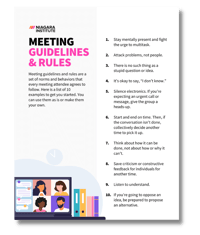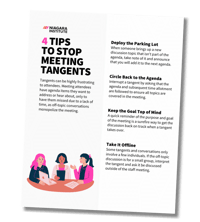3 min read
[Infographic] Staff Meeting Stats: The Good, the Bad, and the Ugly
Whether the attendees include an intact team, a single department, or an entire company, staff meetings are a chance for information to be exchanged,...
3 min read
 Michelle Bennett
:
Mar 12, 2024 5:00:00 AM
Michelle Bennett
:
Mar 12, 2024 5:00:00 AM

When you lead a meeting, your leadership abilities are front and center for everyone to see. While how you lead a meeting may not be a fair assessment of your true leadership capabilities, like it or not, those around you will assess you as a leader based on how well the meeting is run.
Avoiding these two common mistakes will increase the likelihood that your meeting will run smoothly, leaving a positive perception of your leadership in the minds of attendees. With some upfront work and know-how, you can steer clear of these common pitfalls that derail meetings and leave attendees frustrated.
Many common grievances attendees have regarding meetings at work could be avoided by setting ground rules. Ground rules are a set of norms and behaviors that everyone agrees to follow for the meeting to not only meet its objective but for it to be a constructive and inclusive environment rather than a destructive one where feelings get hurt, turf wars start, and egos get in the way of meaningful progress.
Poor behavior in meetings is, unfortunately, commonplace. According to a study conducted by The University of Amsterdam, those polled listed these as the top destructive behaviors in meetings, all of which can be avoided by setting ground rules.
.png?width=750&height=422&name=Top%205%20Destructive%20Behaviors%20in%20Meetings%20(1).png)
Ideally, you would set meeting ground rules in one of your first meetings as a team, though if you haven’t yet, there’s no better time than the present to do so. Also, if you set ground rules for your meetings alone in a silo and then tell your attendees to follow them, it will likely have the opposite effect of what you intend. So, be sure to brainstorm and create a set of ground rules as a group and then get agreement from everyone that they are willing to stick to them going forward. To help you get started, here is a list of meeting guidelines and rules you can use with your own team.
To help you get started, here is a list of meeting guidelines and rules you can use with your own team.
In a survey of 757 workers in the United States, the number one choice for the most significant meeting challenge was tangents and off-agenda conversations. Tangents can be highly frustrating to attendees. Meeting attendees have agenda items they want to address or hear about, only to have them missed due to a lack of time, as off-topic conversations monopolized the meeting. Leading a meeting requires addressing off-topic conversations to get the agenda back on track and ensure attendees find value in your meeting. Here are four ways to stop tangents when they arise.
Leading a meeting requires addressing off-topic conversations to get the agenda back on track and ensure attendees find value in your meeting. Here are four ways to stop tangents when they arise.
Becoming proficient at leading a meeting is like learning any skill; it takes knowledge and practice to become great at it. Luckily, with a partner like Niagara Institute, you can learn the skills you need to lead productive meetings. With programs covering communication and leadership skills, as well as, opportunities to work with a leadership coach, you can get the skills you need to lead better meetings.
![[Infographic] Staff Meeting Stats: The Good, the Bad, and the Ugly](https://www.niagarainstitute.com/hubfs/Staff%20Meeting%20Stats%20Infographic%20Featured%20Image.png)
3 min read
Whether the attendees include an intact team, a single department, or an entire company, staff meetings are a chance for information to be exchanged,...

4 min read
In a recent study about 1:1 meetings, 250 direct reports were asked to rate their experience. Nearly half rated it as suboptimal. According to...

6 min read
Whether it’s a monthly management meeting, an annual leadership summit, or an executive offsite, these meetings can become predictable and stale over...